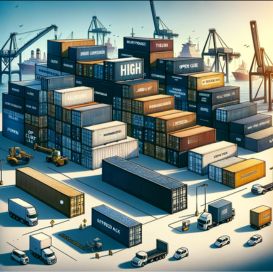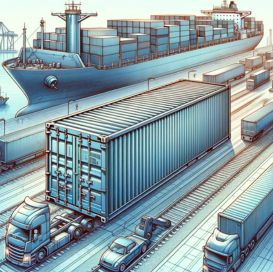
Shipping containers go by many different names, including cargo containers, sea cans, and storage containers. However, the most common name for a shipping container is simply “container.”
Containers are standardized reusable units that provide secure and efficient transportation of goods and products globally. The standardized design enables stacking and transfer between ships, trains, and trucks with ease.
In this guide, I will provide you with a list of shipping container names.
List of Shipping Container Names
Shipping Container
Shipping container is the most universally understood term that encompasses the variety of uses for these standardized containers. Shipping containers revolutionized global trade, enabling the intermodal transport of goods in high volumes. They significantly reduced shipping times and costs. The simple term shipping container is widely understood worldwide.

Cargo Container
The term “cargo container” is derived from the ability of these units to store, protect, and transport a variety of goods and freight across the world. This is one of the most popular shipping container names in use throughout the United States, Canada, and the United Kingdom. Cargo containers allow goods to be packed at the point of origin and sealed for secure delivery all the way to the final destination without having to be opened. This enables much faster loading and unloading of cargo compared to traditional break bulk shipping methods. Cargo containers provide security, traceability, and accountability for shippers.
Intermodal Container
Intermodal containers are designed to be transported using multiple modes of transportation without having to unload and reload the contents. This name reflects the containers’ ability to go from ship to rail to truck seamlessly. The standardized dimensions allow stacking on ships, double stacking on trains, and trucking on chassis. Intermodal containers transformed shipping by eliminating repeated handling of cargo. This significantly reduced shipping times, costs, and damages. It also enabled true door-to-door service without disruption at modal changes.

ISO Container
ISO containers meet the specifications set by the International Organization for Standardization (ISO). To receive an ISO certification, a container must meet strict dimensional and design standards. There are 5 major sizes of ISO containers to choose from based on cargo volume. The rigorous ISO standards enable containers to be efficiently stacked, loaded, and transferred between different modes of transport globally. They also ensure uniformity, so containers can be handled by standardized equipment worldwide.
Sea Container
Sea Container refers to the common use of these containers for overseas shipping transport. They are designed to withstand the journey across oceans while protecting the cargo inside. Sea containers are built to handle months at sea and harsh weather conditions. They are made of corten steel, which is durable and corrosion resistant. Features like locking bars, ventilated sides, and waterproof seals protect the contents inside. This allows goods to be safely transported to international destinations by sea.
Sea Can
Sea can is a popular colloquial name for shipping containers, especially in Canada. It refers to the container’s sturdy build and sea-faring transportation. The term sea can is used frequently in the trucking, rail, and intermodal industries to refer to shipping containers. Sea cans provide secure containment for goods being moved from ports to inland destinations. Their standardized handling makes sea cans efficient and cost effective for moving cargo.
Container Van
Container van is a common name used in the Philippines for shipping containers. It refers to the box design that allows overland transport by truck. Container vans allow the modular and protected benefits of containers for domestic shipping. Goods can be loaded at origin and securely delivered to destination without handling. Container vans are available in smaller sizes for trucking and inter-island transport.
Moving Container
Moving containers are designed for transporting household goods for relocation. They have swing-out doors for easy access when packing and securing cargo. Moving containers provide a flexible and secure solution for moving personal possessions over long distances. They can be conveniently loaded on site and then trucked to the new destination. Moving containers are weatherproof and can also provide temporary storage during a move.
Freight Container
Freight containers refer to the use of containers for transporting large volumes of commercial cargo or freight. This name is commonly used in Australia. Containers enable high volumes of freight to be transported efficiently. Goods can be unitized into standard containers at the origin and destuffed at the destination. Freight containers offer security and traceability while eliminating repeated cargo handling. They provide a cost effective solution for shipping commercial freight domestically or overseas.